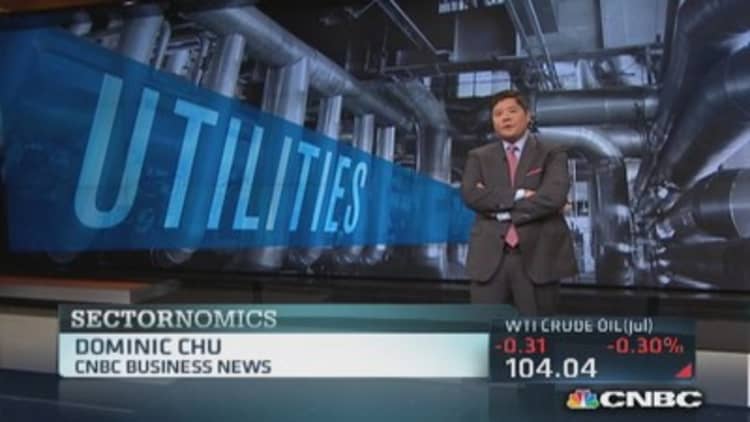
It's been another rough month for U.S. investors, with all of the country's major indexes mostly flat since the beginning of May. To deal with the ups and downs that has plagued the market this year, many weak-stomached stock pickers have moved into more defensive industries, including the utilities sector, which is often considered the most defensive sector of them all.
Since January, the S&P 500 Utilities Index has climbed 10 percent. It's been the best-performing sector by a huge margin—the second best performer is energy, with a 6.4 percent gain—and it has dramatically outperformed the S&P 500 itself by nearly 7 percentage points.
Karalyn Carlton, founder and managing director of Seattle-based Carlton & Company Financial, isn't surprised to see the sector outperforming in today's volatile stock market environment. Utilities play an important part in her portfolios, and it's a must-own for her retired clients who are in need of income.
"It's a staple for a portfolio, especially income ones," she said. "It has dividends, modest growth, and it's less volatile than other equities."
Top dividend-paying utility stocks
| Ticker | Security Name | Div Yield |
| TE | TECO Energy | 5.14 |
| SO | Southern Company | 4.86 |
| TEG | Integrys Energy Group | 4.68 |
| ED | Consolidated Edison | 4.65 |
| FE | FirstEnergy Corp. | 4.56 |
Source: Source: CNBC data (through 5/23)
Income seekers and defensive investors have always had an affinity for electric utilities. Today, many have yields of 3.5 percent to 5 percent and have annual capital gains of around 3 percent. Over the long term, investors can get an annual total return of 6.5 percent to 10 percent, said Carlton.
Part of the reason it's an attractive space for retirees is that it's so reliable. It collects recurring revenues every month in good times and bad. People need to heat and power their homes, and while weather can affect how much electricity is used, usage is generally consistent year after year.
Read MoreMore dividends being added in this sector than any other
Interest-rate sensitive
While it might seem as though investing in this sector is a no-brainer for older and more conservative investors, people can't jump into this blindly. As well as the sector has done, those positive returns could turn negative quickly if interest rates start to rise.
"This is a big deal," said Christopher Muir, an equity analyst with S&P Capital IQ. "If interest rates change quickly, utilities won't have time to react, and they'll suffer."
Late last year, investors saw just how damaging a rate change can be. Between January and April 2013, the sector rose 16.3 percent. Then, in May, the Federal Reserve announced that it would likely start tapering its bond purchases. The 10-year Treasurys' yield quickly climbed, hitting 2 percent on May 22 and jumping to 3.04 percent at the end of last year. Over the last eight months of the year, the utilities index plummeted by 8.2 percent.
Utilities stocks are so interest-sensitive, precisely because of their stability. Many people buy these companies as a proxy for bonds. If someone can't get a good yield on a fixed-income instrument, they'll look to a utility for that income.
Of course, as bondlike as these stocks are, they're still stocks. So when bond yields rise, fixed income starts looking more attractive. Many investors would still rather buy a bond with a good yield than equity with an attractive payout.
Read MoreAre you better off buying bonds or bond funds?
"Utilities will have to compensate for the higher bond yields," said Muir. "If yields go up too quickly and they can't increase dividends, then that makes them less attractive and prices will drop."
One reason why the sector has done well this year is that the 10-year Treasurys' yield has actually fallen—it's at 2.55 percent as of May 20—so these stocks look more attractive, said Steven Krichbaum, an associate portfolio manager with T. Rowe Price.
Of course, no one knows when it might climb again.
As long as investors are aware of how these stocks perform when rates rise, they should make for a good investment. Right now the supply-and-demand fundamentals for energy is the best it's been since 2008, said Krichbaum.
For the last several years, there's been more supply than demand for electricity. That's changing. Over the last few years, a number of old coal plants have closed, and more will likely shut down due to stricter carbon emission regulations that were proposed in September's Clean Air Act. It will be too expensive to upgrade these coal plants to meet the new standards, he said.
Natural gas power plants have also been hurt by all-time low commodity prices, said Maura Shaughnessy, a portfolio with MFS Investment Management. Prices, though, are starting to pick up—gas is now $5.13 per thousand cubic feet—and that will help boost earnings.
"Natural gas sets the marginal price for a lot of power plants around the country, and we've had this great uplift in natural gas prices," she said, adding that the cold winter has also helped increase demand for electricity and lower gas supplies.
Read More
Regulated vs. nonregulated
Before you buy, decide whether you want to own regulated or nonregulated utilities, or companies that are both.
Regulated utilities, such as ITC Holdings Corp. (NYSE: ITC) and PNMResources (NYSE: PNM), are less volatile than unregulated ones, but they can also be slower growers. These companies operate power plants and deliver power to homes. They have to follow rules set out by state governments and can increase rates by only a modest amount every year.
Any renegotiation of rates has to be approved by the state, so it's important to look for a company that has operations in regulator-friendly jurisdiction, such as in California and Colorado, said Krichbaum.
Unregulated operations—which only exist in states where power production has been deregulated, such as New Jersey and Texas—generate the electricity that goes into homes. They might sell that power to a regulated utility that then delivers to people. Some do both. Muir's top unregulated companies are NRG Energy (NYSE: NRG) and AES (NYSE: AES).
Unregulated utilities, which are also called independent power producers, have been struggling over the last few years, as they're most affected by supply-and-demand fundamentals. However, as demand increases and supply falls, Shaughnessy thinks this part of the market will finally turn around.
What to buy depends on individual preference, said Muir. If you're looking for more growth and are willing to take more risk, then look at unregulated or integrated producers. If you want a more bondlike stock, then go with regulated companies.
Dividends and drivers of growth
Whatever you buy, it's important to purchase a company that has a history of expanding payouts every year, said Muir. You also want to own operations in growing parts of the country, such as Arizona and Florida—one way utilities can increase profits is by selling more electricity to more people—and try to find companies that are attractively valued.
The sector is currently closer to fair value, with stocks trading 15.5 to 26 times 2015 earnings. The unregulated utilities are at the higher end, said Muir.
Investors can also buy mutual funds or exchange-traded funds, but look at what's in each fund, said Carlton. Some funds only hold utility companies, while other utility funds also hold telecoms and industrials. The Utilities Select Sector SPDR Fund (NYSE Arca: XLU) is the largest and oldest pure-play utilities ETF.
Top-performing utility stocks in S&P 500
| Ticker | Security Name | YTD % Chg |
| POM | Pepco Holdings | 44.80% |
| EXC | Exelon Corporation | 25.10% |
| NRG | NRG Energy | 18.00% |
| PEG | Public Service Enterprise Group Incorporated | 17.30% |
| ETR | Entergy Corporation | 17.00% |
Source: Source: CNBC data (through 5/23)
Whether you choose the pure-play option or the more broad-based one will depend on why you're investing in the sector, said Carlton.
Her moderately conservative income-seeking clients would have 15 percent to 20 percent of their assets in a more pure utilities fund, while a moderately aggressive investor—one who wants to own utilities to reduce portfolio volatility—would have no more than 5 percent in a broader-based fund, she said.
At the moment, Carlton is sticking with her current utilities positions. She bought some last year when the market dropped, but whether she'll add more depends on where interest rates go and whether other, more growth-oriented, sectors start to pick up again.
However, she'll always hold on to some utilities, even if rates do rise. "This should be part of a portfolio," she said. "It's a steady eddy sector that's usually pretty predictable."





